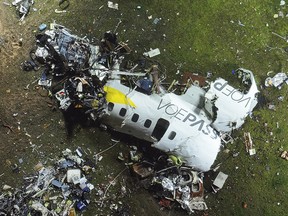This comes after one of the safest years on record for the international airline industry: In 2023, there wasn’t a single fatal accident aboard a commercial jet plane

The deaths of 179 people in a Jeju Air plane crash at Muan International Airport in South Korea has renewed interest in the safety of air travel.
“2024 has been less safe than recent years, but the last decade has been by far the safest in airline history, and all the signs are that it will — largely — stay that way,” wrote David Learmount, an aviation journalist, in an email to National Post.
The crash came just days after an Azerbaijan Airlines flight crash landed in Kazakhstan on Christmas Day, killing 38 people. However, that crash wasn’t an “accident,” as might be normally classified in the air travel world, because it appears to have been shot down by Russian air-defence systems rather than something mechanical or flight-crew related having gone wrong that led to the crash.
Nevertheless, the combined death total of 318 in 2024 is the largest number of air-travel fatalities since 2018, the year that a Lion Air flight on a Boeing 737 MAX 8 crashed in the Java Sea, killing 189 people. There were multiple other fatalities that year, too.
In addition to the deaths in Kazakhstan and South Korea in 2024, five members of Japan’s coast guard were killed when their plane collided with a Japan Airlines plane that was landing at Tokyo’s Haneda Airport on Jan. 2, 2024; 18 people were killed when an Nepalese plane crashed at Kathmandu’s airport in late July; and a Brazilian passenger plane crashed into a residential neighbourhood in Sao Paulo in August — all 62 passengers died.
“This year, the air transportation industry will have transported five billion passengers around the globe and so I think that’s important to put that in context,” Hassan Shahidi, the president and CEO of the Flight Safety Foundation, said in an interview.
However, the international airline industry was coming off one of the safest years on record: In 2023, there wasn’t a single fatal accident aboard a commercial jet plane.
A database managed by the Flight Safety Foundation and the Aviation Safety Network shows one medical death aboard a jet plane in 2023 — in that case, the pilot died — and 10 related to the crash in Russia that was carrying executives from the Wagner Group mercenary outfit.

Over the past several decades, there has been a steady decline in the number of fatal accidents aboard commercial airliners. There were, for example, more than 50 fatal accidents aboard commercial airplanes in 1996, according to the Flight Safety Foundation. That was the year a Saudi Arabian Airlines flight collided mid-air with a Kazakhstan Airlines flight, killing 349 people in the deadliest-ever mid-air collision. It was also the year a Trans World Airlines plane exploded over the Atlantic Ocean shortly after departing New York City, killing 230 people.
Still, “when we look at accidents, they are rare,” said Shahidi.
This is especially true in the broader historical context.
All this is happening, aviation authorities note, as the number of flights each year have ramped up dramatically.
“We want to understand more fully the relationship between turbulence and climate change and scientifically. But certainly we’re tracking that, and we believe that that is a growing concern,” said Shahidi.
Still, some safety practices are up to passengers.
“If you’re wearing a seatbelt, if you’re strapped in, the chances of injury is very minimal,” said Shahidi. “The airlines are now redoubling their efforts to keep the seatbelts on all the time except when you have to go to the restroom. So those are some of the practices being put in place to reduce that risk.”
Conflict zones and troubled areas of the globe are also of particular concern for air safety. In January 2020, Iran used surface-to-air missiles to shoot down Ukraine International Airlines Flight 752 as it departed Tehran, killing 176 people. The Azerbaijan Airlines crash and the 2014 Malaysia Airlines crash were both shot down during the decade-long Ukraine-Russia conflict.
“There are responsibilities, regulations and guidance that both airlines and regulators and states have to follow to make sure that civilian aircraft are not put at risk,” said Shahidi.
— With additional reporting by Bloomberg News
Our website is the place for the latest breaking news, exclusive scoops, longreads and provocative commentary. Please bookmark nationalpost.com and sign up for our newsletters here.